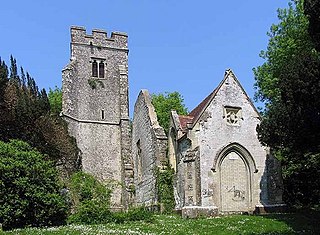Bury is a village and civil parish in Cambridgeshire, England. Bury lies approximately 7 miles (11 km) north/north east of Huntingdon and is near to Ramsey and St Ives. Bury is situated within Huntingdonshire which is a non-metropolitan district of Cambridgeshire as well as being a historic county of England.

Foxearth is a village and civil parish on the borders of north Essex and Suffolk in England, between Long Melford and Cavendish. The neighbouring parishes are Borley, Belchamp Walter, Belchamp Otten, Liston and Pentlow.

Eastwell is a hamlet and civil parish about 3 miles (5 km) north of Ashford, Kent, England. The 2011 Census recorded the parish's population as 103.

Tonge is a village near Sittingbourne in Kent, England. The hamlet is north of Bapchild, close to Murston Marshes beside the Swale.

Boughton Place, formerly Bocton Place or Bocton Hall, is a country house in Boughton Malherbe, Kent, England. It is the historic home of the Wotton family and birthplace of Sir Henry Wotton (1568–1639), ambassador to Venice under James I.

All Saints, Frindsbury, is a parish church serving the combined parish of Frindsbury with Upnor and Chattenden. The church dates from 1075 and lies in the north-west corner of the Medway Towns, historically part of Kent, England. It is a Grade II* listed building, National Heritage List number 1107886.

St Mary's is a parish church in Lenham, Kent, England, begun in the 12th century with additions in the next three centuries. It is a Grade I listed building.
Henry Horne was an English politician.

Norton, Buckland and Stone is a small rural civil parish 1 mile (1.6 km) east of Teynham and 3 miles (4.8 km) west of the centre of Faversham in the borough of Swale, Kent, England. It is bypassed by the M2 to the south and traverses the historic A2, on the route of the Roman road of Watling Street.
Philip Chute or Chowte, of Horne Place, Appledore, Kent, was an English member of parliament in Elizabethan England. He is the progenitor of Chute dynasty in England and Ireland from the Chutes of Hampshire and Norfolk, and during the plantation of Limerick a branch moved to settled at Chute Hall.

All Saints Church is a parish church in Hollingbourne, Kent. It was begun in the 14th century and is a Grade I listed building. The church contains numerous monuments to the local Culpeper family.

All Saints is a parish church in Ulcombe, Kent. It was begun in the 12th century and is a Grade I listed building.

St Nicholas' Church is a Grade I listed Church of England parish church dedicated to Saint Nicholas, in Fulbeck, Lincolnshire, England. The church is 9 miles (14 km) north from Grantham, and at the southern edge of the Lincoln Cliff in South Kesteven.

St Vincent's Church is a Grade I listed Church of England parish church in Caythorpe, Lincolnshire, England. It is at the southern edge of the Lincoln Cliff in South Kesteven, and 10 miles (16 km) north from Grantham.

St Mark's Anglican Church is a heritage-listed church at 55 Albion Street, Warwick, Southern Downs Region, Queensland, Australia. It is the second church of that name on that site. It was designed by Richard George Suter and built in 1868 by John McCulloch. It was added to the Queensland Heritage Register on 21 October 1992.

St Mary and St Peter's Church is a Grade I listed Church of England parish church dedicated to Saint Mary and Saint Peter in Harlaxton, Lincolnshire, England. The church is 2 miles (3 km) south-east from Grantham, and at the eastern edge of the Vale of Belvoir in South Kesteven.

Ralph St Leger of Ulcombe in Kent was Sheriff of Kent in 1467/8 and was constable of Leeds Castle in Kent. He was a member of the St Leger family.

St Andrew and St Mary's Church is a Grade I listed Church of England parish church dedicated to Saint Andrew and Saint Mary, in the parish of Easton and the village of Stoke Rochford, Lincolnshire, England. The church is 5 miles (8 km) south from Grantham, and at the western side of the Lincolnshire Vales in South Kesteven.
Bowyer Hendley was an English landowner who served as High Sheriff of Kent.

St Botolph's Church is an Anglican church in the village of Lullingstone, in Kent, England, situated on the lawn of Lullingstone Castle. It dates from the 14th century with later modifications, and it is a Grade I listed building.

















